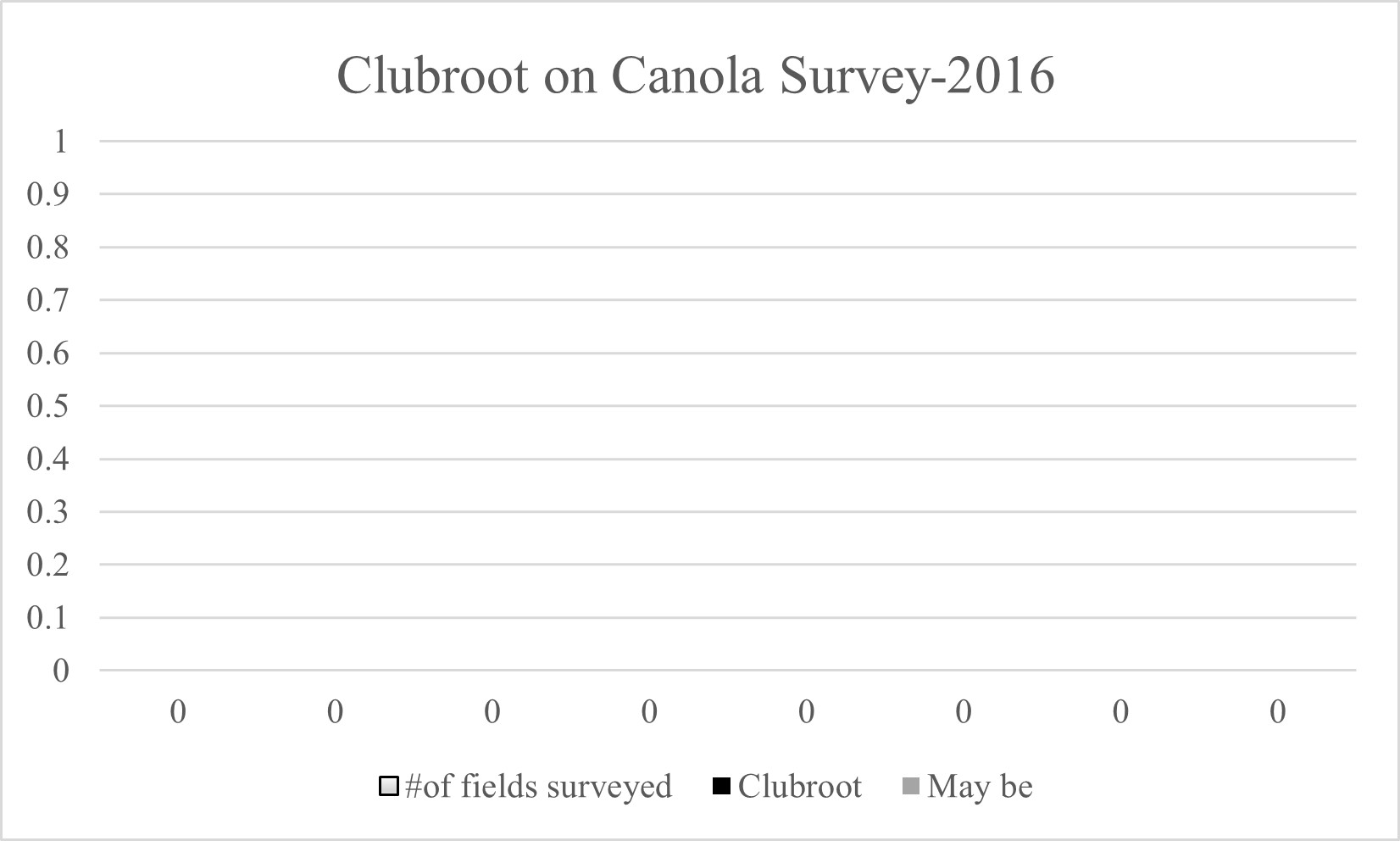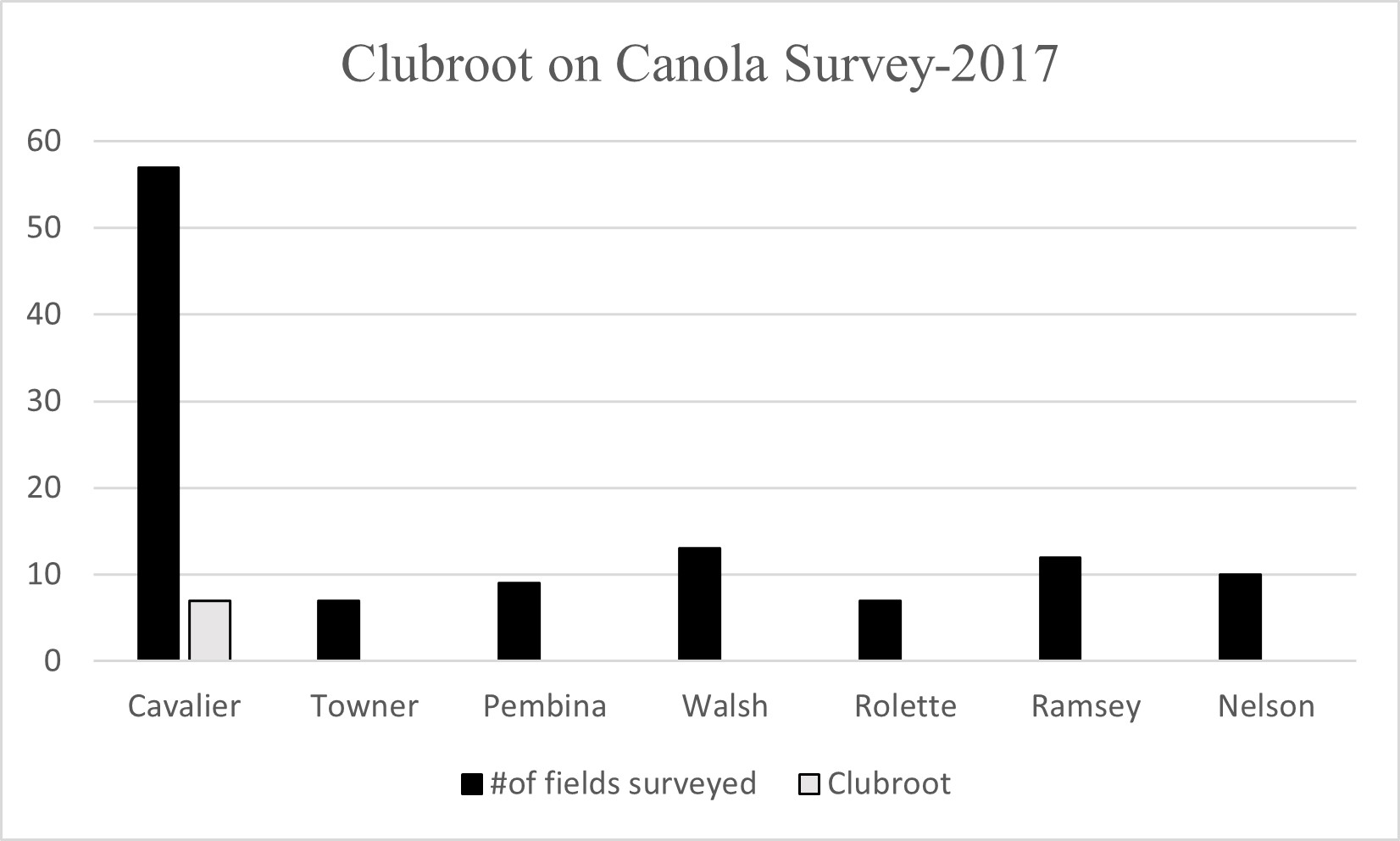In 2016, 119 fields in eight counties were surveyed by our research group (Figure 1). One positive clubroot field has been identified in Cavalier County. The level of clubroot incidence in the positive clubroot field was 99% with maximum severity of root galling (Rating Scale range 3). One field in Ward County (Figure 1) was found with severity rating of 2. The molecular analysis (Polymerase Chain Reaction) report from Dr. Luis Del Rio indicated negative to clubroot. The clubroot like symptoms on canola root can be attributed to root hybridization in canola, which is often confused with clubroot symptoms.
Figure 2: Fields surveyed in 2017 for prevalence of clubroot over 8 counties.
In 2017, 115 canola fields were surveyed and seven fields have been identified as potentially infected with clubroot. Samples were sent for molecular diagnosis to Dr. Luis Del Rio’s laboratory in Fargo.
Determination of Soil pH: Soil samples from clubroot positive fields and from the clubroot suspected fields were collected as per the procedure described by the Manitoba Agriculture, Food and Rural Development (MAFRD), Canada. The soil samples were submitted to the NDSU soil-testing laboratory in Fargo and the soil pH is presented in Table 1.
Table 1: Latest pH of soil samples collected in each county from canola fields during the 2017 clubroot survey.
| | GPS Coordinates | | |
|---|
Depth of soil sample | pH | N | W | County | Clubroot Response |
0-6 | 6.46 | 48. 54. 612 | 98. 04. 805 | Cavalier | Negative |
0-6 | 6.96 | 48. 47. 405 | 98. 12. 758 | Cavalier | Negative |
0-6 | 7.12 | 48. 52. 560 | 97. 17. 661 | Pembina | Negative |
0-6 | 6.45 | 48. 57. 790 | 97. 36. 738 | Pembina | Negative |
0-6 | 7.18 | 48. 26. 733 | 98. 20. 928 | Ramsey | Negative |
0-6 | 7.06 | 48. 42. 256 | 99. 48. 990 | Rolette | Negative |
0-6 | 6.85 | 48. 53. 596 | 99. 39. 401 | Rolette | Negative |
0-6 | 6.97 | 48.48. 909 | 99. 18. 456 | Towner | Negative |
0-6 | 7.26 | 48. 50.908 | 99. 09. 096 | Towner | Negative |
0-6 | 7.19 | 48. 28. 808 | 97. 43. 905 | Walsh | Negative |
0-6 | 8.13 | 48. 34. 342 | 98. 12. 243 | Walsh | Negative |
*All the positive clubroot samples have soil pH ranging from 4.5 to 5.7.
Clubroot on Canola Awareness Meetings:
Clubroot on canola awareness meetings were conducted across the area; five in Cavalier, two in Pembina, two in Walsh, and one in Towner County during the growing season. The survey report were sent at the end of the season to growers and other commodity groups. Ramsey and Nelson counties were covered in the Lake Region Roundup meeting on January 4, 2017. One meeting in Rolette County was conducted the last week of March. The same number of meetings will be conducted in 2018-2019.
Outcome: Meetings on creating awareness of clubroot on canola and its management in various counties showed measurable improvement in growers understanding the disease clubroot on canola. Several growers came forward to cooperate in clubroot management research. Phone calls in the growing season and requests for personal visits to the grower’s fields with clubroot concerns increased. Knowledge of crop rotation, planting resistant varieties and sanitation implementation were the major topics and will be considered for future canola production in the northeastern North Dakota region.
Acknowledgements:
Funding provided by the North Central Canola Research Program and the Northern Canola Grower’s Association in 2016.
Agriculture extension agents who helped in the survey and in conducting clubroot awareness meetings in respective counties.

